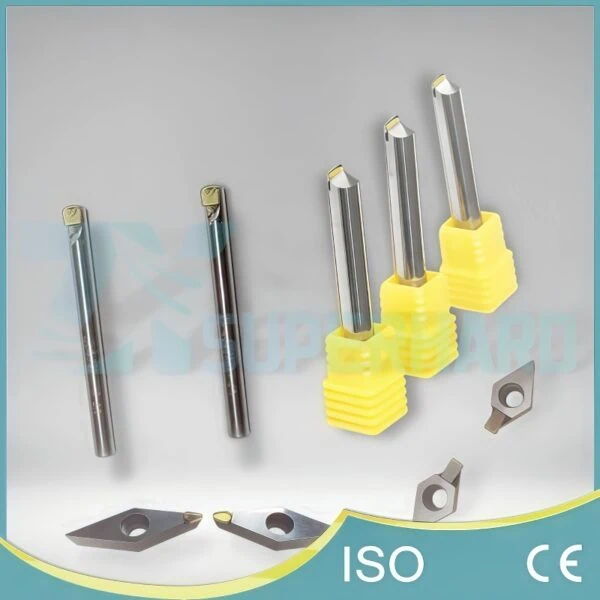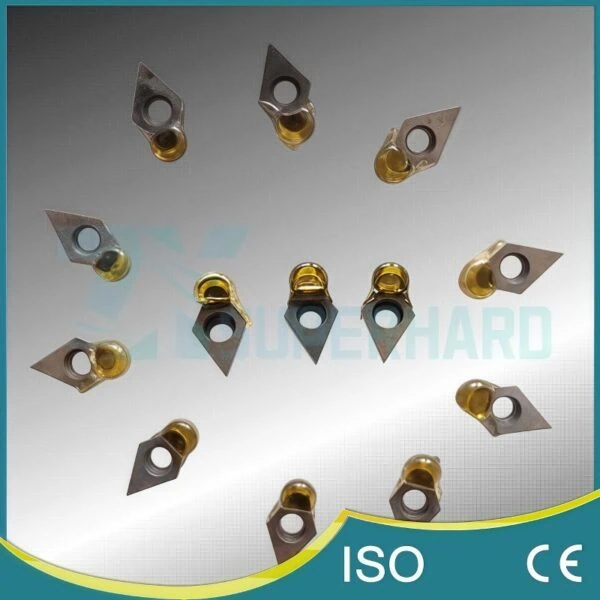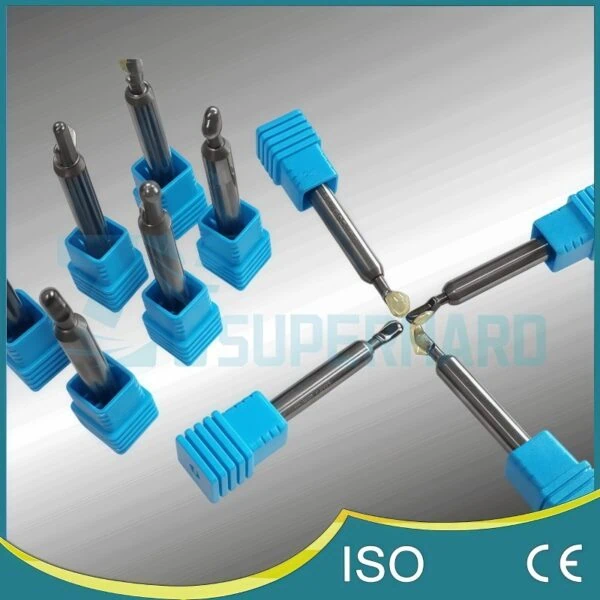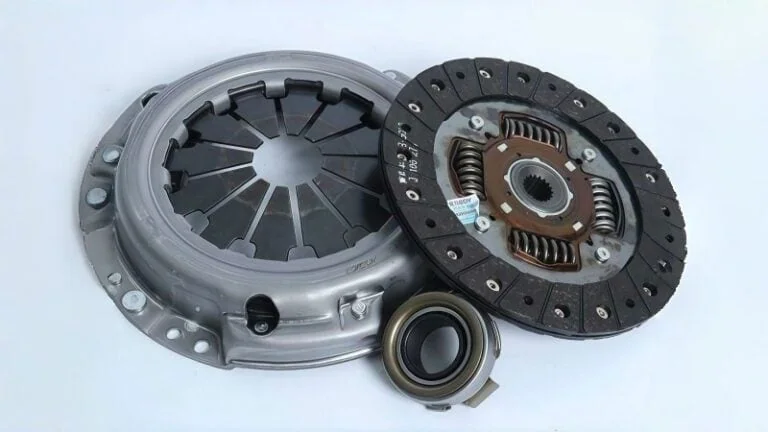-
Whatsapp: +86 13526572721
-
Email: info@zydiamondtools.com
-
Address: AUX Industrial Park, Zhengzhou City, Henan Province, China
-
Whatsapp: +86 13526572721
-
Email: info@zydiamondtools.com
-
Address: AUX Industrial Park, Zhengzhou City, Henan Province, China

Monocrystalline Diamond (MCD) Tools Explained: Achieving Ultimate Precision & Mirror Finishes

Thinking about using Monocrystalline Diamond tools to get ultimate precision or mirror finishes, but need the full picture first?
Monocrystalline Diamond (MCD) tools are cutting tools made from a single, perfect diamond crystal, enabling unparalleled sharpness for achieving ultimate precision and mirror finishes, primarily on non-ferrous metals and polymers. While offering key benefits like superior surface quality and dimensional accuracy often eliminating post-processing, they come with trade-offs including high initial cost and material brittleness, making them most suitable for specific high-value finishing applications in optics, medical, electronics, and luxury goods sectors.
What Makes Monocrystalline Diamond Unique for Tooling?
So, what exactly sets monocrystalline diamond apart when it comes to making tools used in precision manufacturing?
Monocrystalline diamond (MCD), also known as single-crystal diamond (SCD), stands out for tooling primarily because of its single, continuous crystal lattice structure1. This flawless, uniform structure results in exceptional hardness, high resistance to wear, and excellent ability to conduct heat. Most importantly, this structure allows MCD to be honed to atomically sharp cutting edges, far sharper than those achievable with other tool materials, which is fundamental to its ultra-precision capabilities.
The Edge of Perfection: Understanding the Single Crystal Structure
Imagine a diamond that isn’t made of many tiny diamond pieces glued together, but is instead one perfect, unbroken diamond crystal throughout. That’s the essence of monocrystalline diamond.
Unlike Polycrystalline Diamond (PCD)2, which consists of many small diamond crystals bonded together (like a mosaic tile floor), MCD has a continuous and uniform atomic structure. There are no grain boundaries – the weak spots or interruptions you find where different crystals meet in polycrystalline materials.
Think of it like this:
- PCD: Similar to a wall built from many small bricks. The mortar joints (grain boundaries) are potential weak points.
- MCD: Like a wall carved from a single, solid block of granite. It’s uniform and strong throughout.
This fundamental difference – the absence of grain boundaries – is the key to many of MCD’s unique properties for tooling applications. It leads to predictable, consistent behavior right down to the atomic level.
Key Material Properties: Hardness, Wear Resistance, and Thermal Conductivity
Because of its perfect, uninterrupted crystal lattice, MCD exhibits some truly remarkable material properties crucial for high-performance tooling.
Extreme Hardness
Diamond is famous for being hard, and MCD is no exception. It ranks among the hardest known materials. This extreme hardness means it can cut other tough materials without easily deforming. It also allows the tool to maintain its precise shape for longer periods during use.
Excellent Wear Resistance
Hardness directly contributes to wear resistance. Because MCD is so hard and has that uniform structure, it resists abrasion exceptionally well. This means MCD tools don’t wear down quickly, even when machining abrasive materials (within their suitable application range, primarily non-ferrous materials). This leads to longer tool life compared to less hard materials under the right conditions.
High Thermal Conductivity
MCD is one of the best thermal conductors known – much better than copper! What does this mean for tooling? It means that the heat generated at the cutting edge during machining can be quickly drawn away from the tip and dissipated through the tool body (High Thermal Conductivity3). This helps to:
- Keep the cutting edge cooler, reducing thermal damage and wear.
- Prevent excessive heat buildup in the workpiece, which is critical for maintaining dimensional accuracy and preventing material damage, especially in delicate parts or heat-sensitive materials like polymers.
It’s worth noting that specific values for hardness and thermal conductivity can sometimes vary slightly depending on the diamond’s quality, orientation, and the specific synthesis process used by the manufacturer. For critical applications, it’s always a good idea to confirm these specifications with your tool supplier.
How Atomically Sharp Edges are Possible with MCD
This is perhaps the most defining feature of MCD for ultra-precision work. Remember those missing grain boundaries in the single crystal structure? This allows MCD to be ground and lapped (polished) to an incredibly sharp and smooth cutting edge.
- No Weak Points: Without grain boundaries, there are no inherent weak points along the edge that might chip or break during the sharpening process or under cutting load.
- Continuous Edge: The edge can be formed along a perfect crystal plane, leading to a continuous, unbroken cutting line.
- Nanometer Sharpness: Experts can achieve edge radii measured in nanometers (billionths of a meter) on MCD tools. This is significantly sharper than the edges typically possible on PCD tools (which are limited by the size of the individual diamond grains) or carbide tools.
Why is such sharpness important? An atomically sharp edge shears the material cleanly at a microscopic level, rather than plowing through it. This clean shearing action is what enables the incredible surface finishes and precise details associated with MCD machining.
A Brief Look at MCD Synthesis (HPHT Process)
While natural single-crystal diamonds exist, the MCD used for tooling is typically synthetic, created in a lab under controlled conditions. The most common method is the High-Pressure, High-Temperature (HPHT) process4.
In simple terms, the HPHT process involves:
- Starting with a source of pure carbon (like high-purity graphite).
- Placing it in a specialized press capable of generating immense pressure (often over 5.5 GPa, or more than 54,000 times atmospheric pressure).
- Heating it to very high temperatures (typically above 1400°C or 2550°F).
- Often using a metal catalyst (like iron, nickel, or cobalt) to help the carbon atoms rearrange into the diamond crystal structure.
- Carefully controlling these conditions over time allows a single, high-quality diamond crystal to grow.
This controlled process allows manufacturers to produce MCD crystals with consistent quality and properties tailored for demanding tooling applications, something much harder to achieve with variable natural diamonds.
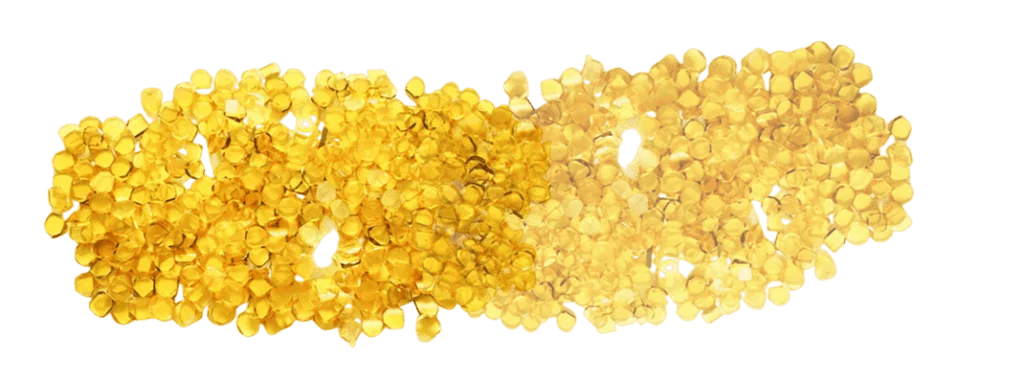
What Common Forms Do MCD Tools Take?
Okay, we know MCD is special, but what kinds of actual tools are made using this special material?
Monocrystalline diamond (MCD) tools come in various forms, each carefully designed for ultra-precision tasks. Common types include standard inserts used in indexable holders, specialized turning and boring tools for lathes, different milling cutters like face and end mills, tools shaped for creating specific features like grooves, profiles, and chamfers, and highly specialized tools such as engravers, grinding wheel dressers, and fly cutters. Furthermore, custom geometry tools can often be manufactured for unique or highly specific applications.
Standard Inserts and Indexable Tooling
Think of these like the replaceable razor blades for a safety razor, but for high-tech machining!
- What they are: Small, precisely shaped pieces of MCD (often brazed onto a carbide base) that are mechanically clamped into a tool holder. (SCD Inserts Example5)
- Why use them: When the cutting edge wears, you don’t replace the entire tool, just the small, less expensive insert. This is common in many machining operations.
- Common Shapes: MCD inserts often follow industry-standard shapes (like triangles, squares, or rhombuses – you might hear codes like TCGT or VCGT), allowing them to fit into standard holders. However, the specific geometry (angles, edge preparation) is optimized for MCD’s properties.
Because insert sizes, shapes, and specific geometries can vary widely between manufacturers and applications, it’s essential to check with your supplier to ensure you get the right insert for your specific holder and task.
Precision Turning and Boring Tools
These tools are typically used on lathes, where the workpiece spins, and the tool shapes it.
- Turning Tools: Used to machine the outside diameter of a spinning part. They often look like a steel shank (the handle) with a small MCD tip precisely brazed or bonded onto the end.
- Boring Tools: Used to machine the inside diameter of a hole in a spinning part, making the hole larger or more precise. Similar to turning tools, they consist of a shank with an MCD cutting tip designed to fit inside the hole.
The key here is that the tool itself moves linearly while the part rotates, allowing the sharp MCD edge to create highly accurate cylindrical shapes.
Milling Cutters (e.g., Face Mills, End Mills)
Unlike turning where the workpiece spins, milling involves a spinning tool cutting a stationary or slowly moving workpiece.
- Face Mills: These are typically larger diameter cutters designed to create large, flat surfaces. An MCD face mill might have one or sometimes multiple MCD inserts mounted on the face of the cutter body. They provide exceptional flatness and finish on materials like aluminum or acrylics.
- End Mills: These look more like drill bits but are designed to cut on their sides as well as their tip. MCD end mills are used for creating slots, pockets, contours, and profiles. They often feature a single MCD cutting edge at the tip or along the side, mounted on a carbide body for rigidity. (MCD Milling Cutter Example6)
Grooving, Profiling, and Chamfering Tools
These tools are shaped to create specific features on a workpiece.
- Grooving Tools: Have a narrow MCD tip designed to cut a specific width and depth channel or groove into a part.
- Profiling Tools: The MCD edge is ground to a specific, often complex shape (like a curve or a combination of angles) to reproduce that exact profile onto the workpiece.
- Chamfering Tools: Designed with an angled MCD edge to create a clean, precise bevel or chamfer on the edge of a part.
The accuracy of the final feature directly depends on the precision to which the MCD tool’s edge itself is shaped.
Specialized Tools (e.g., Engravers, Dressers, Fly Cutters)
Beyond the more common categories, MCD is used for highly specialized tools:
- Engravers: Very fine-pointed MCD tools used for creating precise lines and patterns, often used in decorative applications or for marking.
- Dressers: These are not used to cut the workpiece directly. Instead, MCD dressers are used to shape and sharpen conventional grinding wheels (made of materials like aluminum oxide or silicon carbide), keeping the grinding wheel performing optimally.
- Fly Cutters: Often a simple tool holder with a single MCD tool bit extending from it. When spun at high speed, the single point sweeps across a large diameter, capable of creating extremely flat and smooth surfaces, especially valuable in optics and producing large mirror finishes.
Considerations for Custom Geometry Tools
What if a standard shape just won’t do the job? One of the advantages of synthetic MCD is that it can often be shaped into highly specific, custom geometries.
- Unique Tasks: For very specific applications, like creating a unique medical implant feature or a complex optical surface, a custom-designed MCD tool might be necessary.
- Collaboration: Developing a custom tool usually requires close collaboration between the end-user and the tool manufacturer to define the exact shape, tolerances, and edge requirements.
- Feasibility: While versatile, there are still limitations based on crystal orientation and the manufacturing process. It’s crucial to discuss the feasibility and specifications of any custom MCD tool design directly with potential suppliers.
How Does MCD Stack Up Against PCD and CVD Tools?
MCD sounds impressive, but how does it really compare to other advanced diamond tools like PCD and CVD?
Monocrystalline diamond (MCD) generally offers the sharpest possible edge, leading to the best achievable surface finishes, especially on non-ferrous metals and polymers, making it ideal for ultra-precision finishing. In contrast, Polycrystalline Diamond (PCD) is typically tougher and better suited for roughing and general machining of non-ferrous metals and abrasive composites due to its structure containing many small diamond crystals. Chemical Vapor Deposition (CVD) diamond often provides a balance, with high hardness and wear resistance sometimes exceeding PCD, making it useful for specific abrasive materials, though its edge sharpness doesn’t typically match MCD (PCD vs. CVD comparison7). MCD usually has the highest initial cost, but this can sometimes be offset by eliminating subsequent finishing steps.
Cutting Edge Showdown: Sharpness and Finish Quality Compared
The biggest difference often lies in the cutting edge itself.
- MCD: As we learned, its single crystal structure allows for an atomically sharp edge (think nanometers!). This translates directly into the potential for mirror-like surface finishes. It cuts material with a clean shearing action. You might achieve surface roughness (Ra) values well below 0.025 micrometers (µm) under ideal conditions.
- PCD: Made of many diamond grains sintered together with a binder (like cobalt), PCD’s edge sharpness is limited by the size of these grains and the presence of the binder phase. It can’t achieve the same ultimate sharpness as MCD. While it provides a good finish (perhaps Ra 0.2 – 0.8 µm), it typically won’t be a true mirror finish without polishing.
- CVD Diamond: This is a layer of pure diamond grown chemically. It lacks the binder phase of PCD and can be very hard and wear-resistant. Its edge can be made very sharp, often sharper than PCD, leading to very good surface finishes, but typically still not matching the ultimate sharpness and resulting finish of perfectly prepared MCD.
Important Note: Actual surface finish depends heavily on the material being cut, the machine’s quality and stability, cutting parameters (speed, feed, depth of cut), and tool geometry. The Ra values mentioned are indicative; always consult tool suppliers and conduct tests for your specific application.
Application Sweet Spots: Finishing vs. Roughing Capabilities
Where do these tools shine? Their structures dictate their preferred jobs.
- MCD: Its extremely sharp but relatively brittle edge excels at light, precise finishing cuts. It’s designed to take off very small amounts of material (shallow depths of cut) to achieve the final dimension and surface quality. It’s generally not suitable for heavy material removal (roughing) or interrupted cuts (where the tool repeatedly enters and exits the material), as the delicate edge could chip.
- PCD: The structure with multiple grains and a binder makes PCD much tougher (more resistant to chipping and fracture) than MCD. This toughness makes it the preferred choice for roughing and semi-finishing operations, handling larger depths of cut, higher feed rates, and interrupted cuts in suitable materials.
- CVD Diamond: Often used where high abrasion resistance is key, sometimes even more so than PCD. It can be used for finishing or semi-finishing highly abrasive materials like composites, graphite, or some technical ceramics, where its pure diamond structure resists wear well.
Consequently, each diamond type finds its niche based on structure – whether it’s the extreme precision of MCD, the toughness of PCD, or the wear resistance of CVD.
Material Compatibility Guide: Where Each Diamond Type Excels
Different diamond tools work best on different materials. None of them are suitable for machining ferrous metals like steel or stainless steel due to a chemical reaction at high cutting temperatures that causes rapid tool wear.
- MCD is Ideal For:
- High-purity non-ferrous metals (Aluminum, Copper, Gold, Silver, Brass, Platinum)
- Polymers (Plastics like Acrylic/PMMA, Polycarbonate)
- Certain crystals (Germanium, Silicon – for optics/electronics)
- PCD Works Well On:
- A broader range of non-ferrous metals, including high-silicon aluminum alloys (common in automotive parts)
- Metal Matrix Composites (MMCs)
- Carbon Fiber Reinforced Polymers (CFRP) and other composites
- Graphite
- Wood and wood composites
- Some ceramics (less common)
- CVD Diamond is Often Chosen For:
- Highly abrasive composites and laminates
- Graphite machining
- Some technical ceramics
- Potentially some non-ferrous metals where extreme wear resistance is needed
The choice depends heavily on the specific material grade and the machining operation.
Understanding the Cost vs. Performance Equation
There’s no denying a significant difference in price.
- Initial Cost: MCD tools are generally the most expensive initially. Producing large, flawless single crystals is a complex process. PCD tools are typically significantly less expensive than MCD. CVD diamond tools often fall somewhere in between or can be comparable to MCD depending on the specification. Expect MCD to potentially cost 3 to 5 times (or even more) than a comparable PCD tool, although this ratio varies greatly.
- Total Cost of Ownership (TCO): The higher initial cost of MCD doesn’t tell the whole story. Consider:
- Eliminated Steps: If MCD achieves the required mirror finish or tolerance in one step, it can eliminate costly and time-consuming secondary operations like polishing or deburring, potentially saving significant overall cost.
- Tool Life in Finishing: In its ideal application (light finishing cuts in suitable materials), MCD’s wear resistance can lead to very long tool life, reducing tool change frequency. (However, in roughing or unsuitable materials, PCD would likely last much longer).
- Component Quality: Achieving higher precision or better finish might be a strict requirement that only MCD can meet, making its cost justifiable.
Simple Comparison Summary:
| Feature | MCD (Monocrystalline) | PCD (Polycrystalline) | CVD Diamond |
|---|---|---|---|
| Edge Sharpness | Highest (Atomically Sharp) | Good (Limited by Grain Size/Binder) | Very Good (Pure Diamond Layer) |
| Surface Finish | Best (Mirror Finish Possible) | Good | Very Good |
| Toughness | Lower (More Brittle) | Higher (Better Impact Resistance) | Moderate to High |
| Best For | Ultra-Precision Finishing | Roughing, General Machining | Abrasive Materials, Finishing/Semi-Fin |
| Material Focus | Non-Ferrous (pure), Polymers | Non-Ferrous (incl. alloys), Composites | Composites, Graphite, Some Ceramics |
| Relative Cost | Highest | Lower | Moderate to High |
Remember: Cost ratios and performance benefits are highly dependent on the specific application, materials, machine capabilities, and supplier. Always evaluate based on your unique requirements and consult with tooling experts.
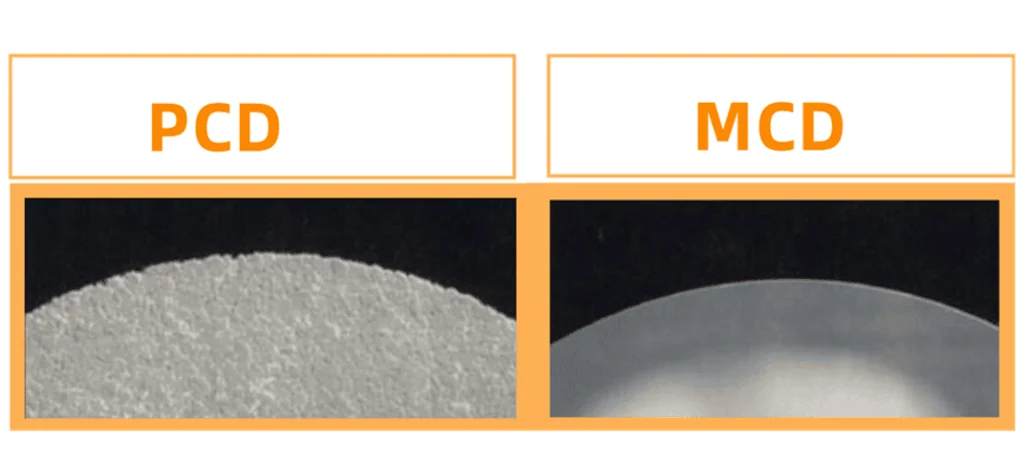
Which Applications Benefit Most from MCD Precision?
We’ve seen what MCD is and how it compares, but where does its incredible precision really make a difference in real-world manufacturing?
Monocrystalline diamond (MCD) tools deliver the most significant benefits in applications demanding the absolute highest precision and surface quality. Key areas include the ultra-precision machining of specific non-ferrous metals like aluminum and copper, achieving flawless mirror finishes on polymers such as acrylics (PMMA), manufacturing critical optical components like lenses and mirrors, producing high-tolerance medical devices including implants and contact lenses, and creating high-value components in consumer electronics, watchmaking, and luxury goods.
Ultra-Precision Machining of Non-Ferrous Metals (Al, Cu, Au, etc.)
MCD truly excels when machining certain soft, non-ferrous metals where achieving a perfect finish and tight tolerances is critical. Why here? Because MCD’s sharp edge cuts these materials cleanly without the chemical reaction issues that occur with steel, and it can produce surfaces requiring little to no polishing.
- Aluminum Alloys: Used extensively for creating high-gloss molds (e.g., for injection molding plastic parts that need a perfect finish), reflective surfaces, and precision components in aerospace and electronics. MCD provides a finish that mold makers value highly.
- Copper: Essential for applications needing high reflectivity or conductivity, such as high-power laser mirrors or precision electrical contacts. MCD can machine copper to exceptional smoothness.
- Gold, Silver, Platinum: In jewelry and high-end electronics (like wire bonding pads), MCD allows for precise shaping and mirror finishing of these precious metals.
- Brass and Bronze: Used for decorative hardware, precision bearings, and musical instrument components where a fine finish is needed.
Achieving Flawless Mirror Finishes on Polymers and Acrylics
Machining plastics to optical clarity or a high-gloss finish can be tricky; conventional tools can cause melting, stress marks, or leave a cloudy surface. MCD’s extremely sharp edge shears through polymers cleanly with minimal heat generation.
- Acrylic (PMMA): This is a prime application. Think of creating crystal-clear light guides for LED lighting, perfectly transparent display screens, high-gloss cosmetic packaging, or polished edges on signage and awards. MCD provides a polished look directly from the machine.
- Polycarbonate (PC): Used for strong, transparent parts, MCD can provide smooth edges and surfaces needed for optical or sealing applications.
- Other Polymers: Depending on the specific plastic, MCD can be used for finishing components needing smooth surfaces and sharp details, such as medical device housings or fluidic components.
Critical Role in Optics Manufacturing (Lenses, Mirrors)
This is where MCD’s capabilities are pushed to the limit. Manufacturing lenses, mirrors, and other optical components requires incredible form accuracy (getting the shape exactly right) and surface smoothness (to minimize light scattering).
- Diamond Turning: A specialized ultra-precision machining process often using MCD tools is employed here.
- Infrared Optics: Materials like Germanium (Ge), Silicon (Si), and Zinc Selenide (ZnSe), used for thermal imaging and other infrared applications, are frequently machined with MCD.
- Metal Mirrors: High-reflectivity mirrors made from aluminum or copper for telescopes, lasers, and scientific instruments rely on the finish only MCD can provide directly.
- Molds for Plastic Optics: Creating the incredibly precise molds used to cast or injection-mold plastic lenses often requires MCD machining.
Advancing Medical Device Production (Implants, Contacts)
The medical field demands biocompatibility (materials safe for the body), often requiring extremely smooth surfaces, along with very tight dimensional tolerances.
- Contact Lenses & Intraocular Lenses (IOLs): MCD is used both for directly machining IOLs (the lenses implanted during cataract surgery) and for creating the ultra-precise molds used to manufacture soft contact lenses. The required smoothness and accuracy are critical for comfort and optical performance.
- Implants: Finishing surfaces on implants made from materials like titanium alloys or biocompatible polymers (like PEEK) is crucial to ensure proper integration with bone and tissue. MCD can achieve the necessary smooth, clean surfaces.
- Surgical Instruments: Certain high-precision surgical instruments or components may utilize MCD machining for critical features.
Use Cases in Electronics, Watchmaking, and Luxury Goods
In these industries, both high aesthetic appeal (perfect shine, sharp details) and functional precision are paramount.
- Consumer Electronics: Achieving a premium look and feel on smartphone casings, laptop bodies, or tablet bezels often involves MCD finishing on aluminum or magnesium alloys. Machining the aluminum platters inside computer hard disk drives also requires extreme precision and smoothness provided by diamond tooling.
- Watchmaking: Creating the high-gloss, flawless finish on watch cases, dials, hands, and bezels, especially from materials like precious metals, brass, or stainless steel (though direct MCD on steel is complex, it might be used on other components), relies heavily on diamond tooling precision.
- Luxury Goods: High-end pens, decorative items, and jewelry often employ MCD for precise engraving, shaping precious metals, and achieving mirror finishes that signify quality.
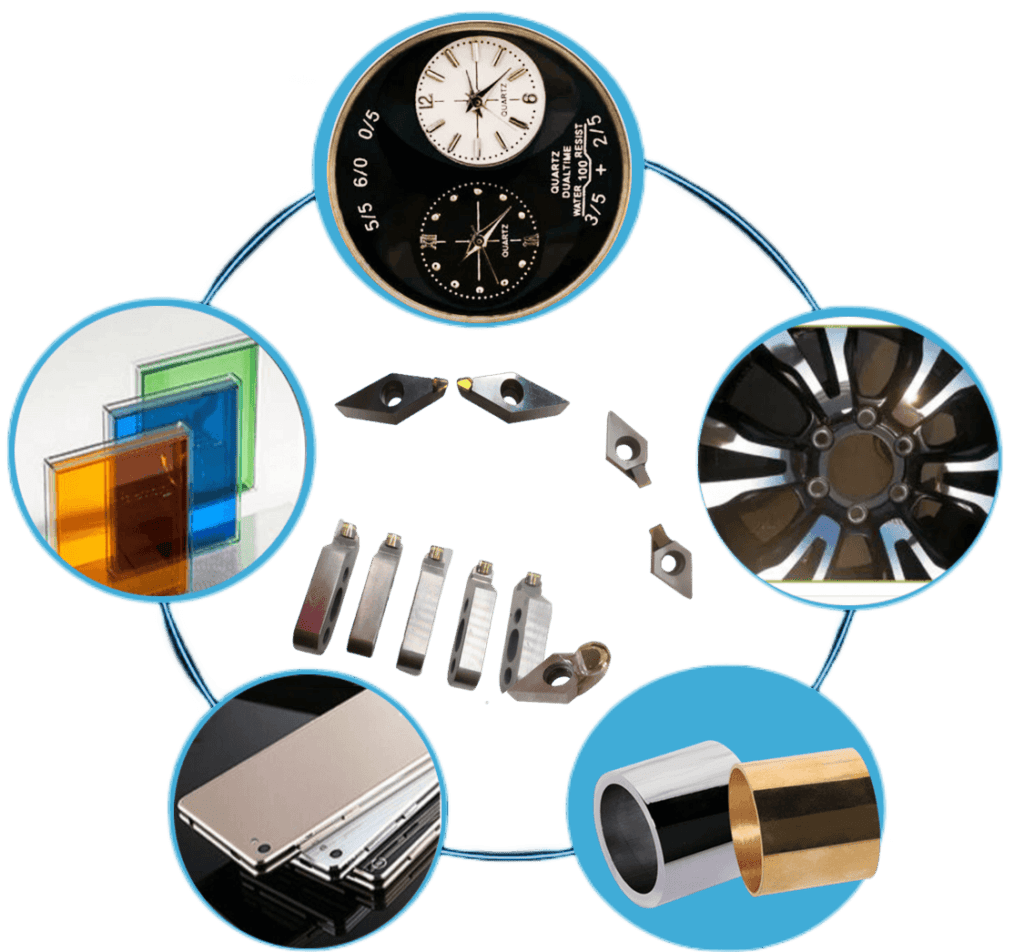
What Are the Key Benefits and Trade-offs of Using MCD Tools?
Using MCD tools sounds powerful for certain jobs, but like any specialized technology, what are the real plus points and the potential downsides you need to weigh up?
The primary benefits of using Monocrystalline Diamond (MCD) tools center on achieving unrivaled surface finishes, often reaching mirror-like quality directly from the machine, which can potentially eliminate secondary polishing or deburring steps. Furthermore, they offer extreme dimensional accuracy and consistency part after part. However, these significant advantages come with clear trade-offs: MCD tools typically have a much higher initial investment cost compared to other tool types, they are relatively brittle and require careful handling and stable machining conditions to prevent chipping, and their application is limited, being generally unsuitable for machining ferrous materials like steel.
Advantage: Unrivaled Surface Finish Quality (Beyond Polishing)
This is often the number one reason engineers choose MCD. Thanks to that atomically sharp cutting edge we discussed earlier, MCD tools can produce incredibly smooth surfaces.
- Mirror Finishes: On suitable materials like aluminum, copper, or acrylics, MCD can create a reflective, mirror-like finish directly during the cutting process.
- Low Roughness Values: Surface roughness (Ra) values can be exceptionally low, often well below 0.025 micrometers (µm), achieving a level of smoothness that’s difficult or impossible to get directly with other cutting tool materials.
- Optical Clarity: For transparent materials like PMMA (acrylic), this translates to excellent optical clarity without the haze or tool marks left by conventional tools.
This capability sets MCD apart, especially when the final surface quality is a critical design requirement.
Advantage: Eliminating Post-Processing Steps (Deburring, Polishing)
Achieving the final desired finish directly on the machine offers significant process advantages.
- Reduced Labor & Time: Secondary operations like manual or automated polishing, lapping, or deburring take time and add labor costs. If MCD machining achieves the target finish, these steps can often be completely eliminated.
- Simplified Workflow: Removing steps simplifies the overall manufacturing process, potentially reducing lead times and complexity.
- Less Part Handling: Reducing handling for extra steps also lowers the risk of parts being damaged or contaminated between operations.
This potential for process consolidation can be a major factor in justifying the use of MCD, despite its higher tool cost.
Advantage: Extreme Dimensional Accuracy and Consistency
The combination of a super sharp edge and high wear resistance means MCD tools can produce parts with exceptional precision.
- Tight Tolerances: MCD tools can hold very tight dimensional tolerances, ensuring parts meet exact size and shape specifications required in fields like optics, medical devices, and micro-electronics.
- Part-to-Part Consistency: Because the tool edge wears very slowly when used correctly, multiple parts can be machined with high repeatability, ensuring consistency across a production run.
- Sharp Features: The keen edge allows for the creation of very sharp corners and fine details without the edge rounding or breaking down quickly.
Trade-off: Higher Initial Investment Costs
There’s no getting around it – MCD tools represent a significant upfront investment.
- Cost Comparison: Compared to standard carbide tools or even PCD tools, MCD tools can cost considerably more, sometimes several times the price for a similar-sized tool. This higher cost stems from the complex and energy-intensive process of synthesizing high-quality single diamond crystals and the precision required to shape and sharpen the tools.
- Budget Barrier: This initial cost can be a barrier, particularly for smaller shops or less critical applications where the ultimate finish or precision isn’t strictly necessary.
- Variability: The exact cost difference depends heavily on the tool type, size, complexity, diamond quality, and supplier. Always obtain specific quotes for your intended tools.
This cost factor means MCD is typically reserved for applications where its unique benefits provide a clear return on investment.
Trade-off: Material Brittleness and Handling Considerations
While diamond is extremely hard, it is also brittle. This means it can chip or fracture relatively easily if subjected to sharp impacts or excessive stress, unlike tougher materials like carbide which might bend or deform first.
- Careful Handling: MCD tools must be handled with care – dropping them or knocking the cutting edge can easily cause damage, rendering the expensive tool useless.
- Stable Machining: They require very stable, rigid, low-vibration machine tools. Any chatter or vibration during cutting can lead to edge chipping.
- Cutting Conditions: MCD is best suited for continuous, light finishing cuts. Interrupted cuts (where the edge repeatedly impacts the workpiece) or attempting heavy roughing cuts significantly increase the risk of premature failure.
- Setup Precision: Precise tool alignment and setup are critical to avoid overloading the delicate cutting edge.
Operators need specific training and discipline when working with MCD tooling.
Trade-off: Limited Application in Ferrous Materials
This is a fundamental limitation based on chemistry.
- Chemical Reaction: At the high temperatures generated during cutting, carbon from the diamond reacts chemically with iron in ferrous materials (steel, stainless steel, cast iron). This reaction causes rapid diffusion wear, essentially dissolving the diamond edge very quickly.
- Application Scope: Consequently, MCD tools are generally unsuitable for machining these common engineering materials. Their use is primarily restricted to non-ferrous metals, polymers, composites, and certain crystals.
This limitation means MCD cannot be a universal solution and must be chosen specifically for compatible materials where its benefits can be fully realized.
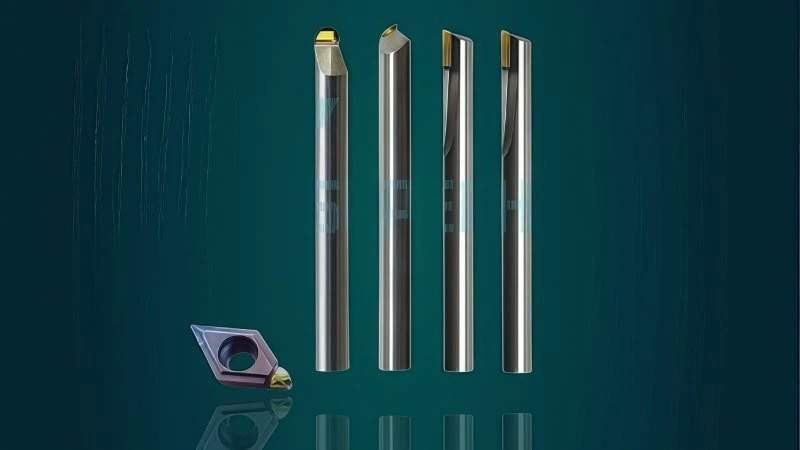
When Should You Choose MCD Over Other Tooling Options?
After learning about its properties, forms, comparisons, applications, and trade-offs, how do you actually decide if MCD is the right choice for your specific job?
Choosing Monocrystalline Diamond (MCD) tools is appropriate when several key conditions are met. You should strongly consider MCD if your application demands the absolute highest surface finish (mirror-like quality), if you are machining compatible non-ferrous metals or polymers, and if the operation primarily involves light, precise finishing cuts. Critically evaluating the total cost of ownership (TCO)8, where the potential savings from eliminated processing steps might outweigh the high initial tool cost, is also essential before making the decision.
Assessing Your Critical Surface Finish Requirements
This is often the starting point. Ask yourself: Just how good does the surface finish really need to be?
- Is Mirror Finish Essential? If your product requires a true mirror finish (like an optical component or a high-gloss decorative part) directly off the machine, MCD is likely your strongest, or perhaps only, option among cutting tools.
- What is the Target Ra? If you have a specific surface roughness (Ra) specification, for example, needing less than 0.05 µm, MCD becomes a primary contender. If a higher Ra (e.g., 0.4 µm) is acceptable, other options like PCD or even fine-finishing carbide might be sufficient and more cost-effective.
- Optical Clarity Needs? For transparent polymers, is perfect clarity required, or is some minor haze acceptable? MCD provides the best chance for pristine clarity.
If the surface finish requirements are less stringent, the justification for MCD’s cost diminishes rapidly.
Evaluating Material Compatibility for Your Project
As we’ve discussed, MCD isn’t suitable for everything. You must confirm:
- Is it MCD-Friendly? Are you machining materials where MCD performs best, like high-purity aluminum, copper, brass, gold, silver, acrylic (PMMA), polycarbonate, germanium, or silicon?
- Is it Ferrous? Are you working with steel, stainless steel, or cast iron? If so, MCD is generally not the right choice due to chemical incompatibility.
- Is it Abrasive or Composite? For high-silicon aluminum, metal matrix composites (MMCs), carbon fiber composites (CFRP), or graphite, PCD or potentially CVD diamond tools are often tougher and more suitable, even if the ultimate finish isn’t quite as perfect as MCD could achieve (before wearing quickly).
Matching the tool material to the workpiece material is fundamental.
Determining if Finishing Operations are the Primary Goal
MCD tools are specialists in finishing. Consider the nature of the machining operation:
- Finishing Pass? Is the main goal of this specific operation to achieve the final dimension and surface quality with a very light cut? This is MCD’s sweet spot.
- Depth of Cut? Are the depths of cut very small (typically micrometers)? MCD excels here. If you need to remove significant amounts of material (roughing), MCD is generally unsuitable due to its brittleness – PCD or carbide would be used first.
- Continuous Cut? Is the cutting action smooth and continuous? MCD prefers this. Interrupted cuts (like milling across slots or holes) impose impacts that can easily chip the delicate MCD edge; PCD is much better at handling interruptions.
If your primary need is roughing or heavy machining, look to other tool materials first.
Calculating the Total Cost of Ownership (TCO) Advantage
Don’t just look at the initial purchase price. You need to estimate the total cost associated with using the tool over its useful life in your specific process. While complex to calculate precisely, consider these factors:
- Initial Tool Cost: MCD is high, alternatives are lower.
- Tool Life: How many parts can each tool type realistically produce in this specific finishing operation before needing replacement or resharpening? (MCD life is good in ideal finishing, poor otherwise).
- Machining Cycle Time: Is the cutting speed/feed different? Usually less relevant for light finishing passes.
- Cost of Secondary Operations: This is often key for MCD. Estimate the cost (labor, machine time, consumables) of polishing, deburring, or lapping if you don’t use MCD.
- Scrap/Rework Rates: Does the higher precision of MCD reduce parts failing inspection?
The equation is essentially: Does the saving from eliminating secondary operations (Point 4) plus any benefits from potentially longer life in finishing (Point 2) and reduced scrap (Point 5) outweigh the higher initial tool cost (Point 1)? If yes, the TCO for MCD might be favorable. Remember that labor rates, cycle times, and scrap costs vary greatly by region and company.
Key Questions to Ask Before Specifying MCD Tools
Before committing to MCD tooling, make sure you or your tooling supplier can confidently answer these questions:
- What is the absolute required surface finish (specify Ra or cosmetic standard)?
- What is the exact workpiece material specification?
- What are the planned cutting parameters (depth of cut, feed rate, speed)?
- Will the cutting be continuous or interrupted?
- How stable, rigid, and precise is the machine tool being used?
- Can we realistically eliminate post-processing steps (like polishing) with MCD? What is the quantifiable value (time/cost saved) of doing so?
- What is the initial tool cost compared to alternatives (PCD, CVD, Carbide)?
- What is the expected tool life for MCD and alternatives in this specific operation?
- Have we performed a reasonable Total Cost of Ownership (TCO) comparison?
- Does our team have the necessary training and discipline to handle delicate, brittle MCD tools correctly to avoid premature damage?
Answering these questions honestly will guide you toward making the most effective and economical tooling choice for your high-precision needs.
Conclusion
Monocrystalline diamond tools represent the pinnacle of cutting tool technology for achieving ultra-precision and mirror-like surface finishes in specific applications. Their unique single-crystal structure enables unparalleled edge sharpness, leading to exceptional results on compatible non-ferrous metals and polymers.
However, MCD is not a universal solution. Its high cost, relative brittleness, and incompatibility with ferrous materials mean it’s a specialized tool that must be applied judiciously. The decision to use MCD hinges on a careful evaluation of surface finish requirements, material compatibility, the nature of the machining operation, and a thorough analysis of the total cost of ownership.
When the application demands the ultimate in precision and finish, and the associated costs and handling requirements can be managed, MCD tools offer capabilities that other cutting tools simply cannot match, making them invaluable in demanding industries like optics, medical device manufacturing, and high-end electronics. Careful consideration and consultation with tooling experts remain key to successfully leveraging the power of monocrystalline diamond.
References
- single, continuous crystal lattice structure1 – ScienceDirect topic page explaining single crystals in engineering materials.
- Polycrystalline Diamond (PCD)2 – ZYDiamondTools blog post providing a comprehensive guide to PCD tools.
- High Thermal Conductivity3 – Britannica explanation of thermal conduction (conductivity).
- High-Pressure, High-Temperature (HPHT) process4 – Gemological Institute of America (GIA) article explaining HPHT and CVD diamond growth.
- SCD Inserts Example5 – ZYDiamondTools product page for Single Crystal Diamond (SCD/MCD) inserts.
- MCD Milling Cutter Example6 – ZYDiamondTools product page for Monocrystalline Diamond (MCD/SCD) milling cutters.
- PCD vs. CVD comparison7 – ZYDiamondTools blog post comparing PCD and CVD diamond cutting tools.
- total cost of ownership (TCO)8 – ZYDiamondTools guide explaining the TCO concept and application for superhard tooling & abrasives.
